造山带常见微细浸染状含金黄铁矿-毒砂矿化(金-硫化物)与脉状自然金-辉锑矿化在空间上密切相关,研究金矿化与锑矿化的时间、空间和成因联系对理解金成矿过程和矿床成因以及找矿勘探有重要意义(Peters et al., 2007; Zhai et al., 2014; Kalinin et al., 2015; Yang et al., 2016a)。大多数研究基于空间上金矿化与锑矿化相伴生,受控于同一构造系统;时间上锑矿化稍晚于金矿化;流体包裹体类型相同,锑矿化阶段均一温度稍低;硫同位素特征相近,反映成矿物质来源一致,认为锑矿化是整个成矿过程演化的一部分(莫儒伟等, 2013; Deng et al., 2014a, 2015; 郭耀宇, 2016)。而另外一些研究依据金矿化形成于挤压环境,而锑矿化形成于伸展环境,二者空间上相邻或无关;金矿化与锑矿化各自形成不同的矿物组合;金、锑矿化形成温度相差较大;时间相隔几十百万年,认为锑矿化与金矿化没有成因联系,锑矿化属于另一个成矿过程(Bierlein et al., 2001; Kovalev et al., 2014; 袁士松, 2015; Jin et al., 2017; Xia et al., 2017)。可见,金矿中微细浸染状金-硫化物矿化与脉状金-锑矿化之间的关系仍存较大争议,在一定程度上制约了对成矿过程和矿床成因的深入理解。
西秦岭是我国最重要的金矿带和最具潜力的金矿接替资源基地之一,已发现上百个金矿床,累计探明金资源储量超过1100t(肖力等, 2008; Chen and Santosh, 2014; Deng and Wang, 2016; Deng et al., 2018),是研究构造演化和复合造山过程中成矿作用的理想选区(邓军等, 2010, 2013, 2016; 杨立强等, 2010, 2014, 2015; Deng et al., 2014b, 2017a; Yang et al., 2014, 2017a)。辉锑矿化广泛发育在西秦岭金矿床中,例如阳山、寨上、枣子沟、加甘滩、马脑壳、金龙山金矿等(刘家军等, 2008; Li et al., 2014; Zhang et al., 2014; 郭耀宇, 2016)。其中,阳山金矿带位于西秦岭造山带南亚带,于1997年由武警黄金部队第十二支队发现,包括安坝等六个金矿床。
前人对阳山金矿带做了多方面工作,取得了大量的数据,积累了丰富的资料。李楠(2013)和Li et al. (2014)基于多尺度观察,提供了较为详细的矿物组合岩相学证据,识别出变质成岩期和热液成矿期,其中热液成矿期包括早阶段、主阶段和晚阶段;应用硫化物微区原位微量元素分析对各阶段成矿流体特征进行了反演,并指出金以晶格金或固溶体形式赋存于黄铁矿和毒砂中,而成矿晚阶段金主要以自然金的形式赋存于辉锑矿-石英±方解石脉中。袁士松(2015)提出阳山金矿存在两期成矿作用叠加:第一期成矿发生在早侏罗世,主要与碰撞造山过程中挤压-伸展转变期大规模构造变形及变质流体相关,形成了黄铁矿、毒砂矿化;第二期成矿发生在早白垩世,主要与陆内造山期隐伏岩浆活动有关,叠加在早期矿化之上,形成石英-辉锑矿化,可见明金,成矿流体以CO2含量略低的岩浆流体为主。可见,由于缺少合适的定年矿物,且具有不同的矿化样式、矿石矿物和金的赋存状态,脉状金-锑矿化与微细浸染状金矿化是否处于同一成矿期,还是应该划分为单独的成矿期,是目前亟需解决的问题。
流体包裹体组合是指“岩相学上可分得最细的有关联的一组包裹体”或“通过岩相学方法能够分辨出来的、代表最细分的包裹体捕获事件的一组包裹体”(Goldstein and Reynolds, 1994),即流体包裹体组合中的所有包裹体是在同一温度和压力下同时被捕获的,且具有近似的流体成分(Bodnar, 2003)。应用流体包裹体组合测温能获得更准确的数据,进而有效反映成矿流体的温压条件(池国祥和卢焕章, 2008; Yang et al., 2016b)。稀土和微量元素在成矿流体中含量较少,但由于其分布的特殊性和稳定的化学性质,常作为成矿地球化学的示踪剂,广泛应用于矿床研究(赵岩等, 2015; Yang et al., 2016c; 肖昌浩等, 2016; Deng et al., 2017b)。本文系统研究阳山金矿带成矿晚阶段流体包裹体组合特征、辉锑矿及石英的矿物学、稀土和微量元素特征,并与成矿主阶段进行对比,分析金矿化与锑矿化的关系,并对其矿床成因意义和找矿意义进行探讨。
1 区域地质西秦岭造山带自北向南可划分为华北板块南缘、秦岭微板块(北秦岭和南秦岭)和华南板块北缘的造山带前陆冲断褶带(含碧口地体、松潘-甘孜地体北部)(张国伟等, 2004)。灵宝-鲁山-舞阳断裂分隔了华北板块与华北板块南缘;洛南-栾川断裂、商丹缝合带和勉略缝合带分隔了华北板块南缘、北秦岭、南秦岭和华南板块北缘;龙门山断裂分隔了秦岭造山带和华南板块。阳山金矿带处于南秦岭和碧口地体之间的勉-略缝合带内(图 1; Dong et al., 2011)。

|
图 1 区域地质简图(据Dong et al., 2011; Wang et al., 2013; Li et al., 2015; Yang et al., 2015b修改) CCO-中央造山带;NCB-华北板块;SCB-华南板块;TLF-郯庐断裂 Fig. 1 Simplified regional geological map (modified after Dong et al., 2011; Wang et al., 2013; Li et al., 2015; Yang et al., 2015b) CCO-Central China Orogen; NCB-North China Block; SCB-South China Block; TLF-Tan-Lu Fault |
区域地层主要包括碧口地体元古代变质火山-沉积岩、寒武-奥陶纪板岩与碳质变沉积岩、志留纪碳质/泥质板岩、泥盆纪千枚岩、结晶灰岩与变质砂岩、石炭-二叠纪结晶灰岩与变质砂岩、三叠纪变质砂岩、板岩与结晶灰岩(图 1; 戢兴忠等, 2014)。其中,碧口地体位于南秦岭微板块以南、华南板块西北缘及松潘-甘孜地体以东的三角地带中,其主体由新元古代碧口群火山-沉积岩系及地体西部的横丹群浊积岩系组成,在东北部出露了新太古代鱼洞子杂岩,并在东部和西北缘发育震旦纪地层(Yang et al., 2015a; 戢兴忠, 2016)。
区域上岩浆岩出露面积较少,总体有如下特点:类型较多,超基性、基性、中酸性火山岩和侵入岩均有出露;区域构造演化对岩浆活动有明显的控制作用;岩浆活动具多期次性,根据构造-岩浆活动的旋回性划分为加里东-华力西期、印支期和燕山期三个构造岩浆事件;空间分布广泛且零散;规模一般较小,侵入岩多呈小岩株或岩脉状产出(杜子图和吴淦国, 1998; Qiu et al., 2016)。
区域地层普遍遭受了区域变质作用,中三叠世末期达到变质作用高峰,变质作用时间不晚于220Ma(Li et al., 1996; 李锦轶等, 1999),构造隆升导致的退变质作用可能持续到大约200Ma(Zhang et al., 2002)。
2 矿床特征阳山金矿带位于西秦岭造山带南亚带,自西向东可分为泥山、葛条湾、安坝、高楼山、观音坝和张家山六个金矿床,已探明含金矿脉100余条,金总资源量超过300t,平均金品位为4.76g/t。各矿床均受到安昌河-观音坝断裂、葛条湾-草坪粱复背斜及NEE向次级断裂的控制(图 2)。赋矿地层为泥盆系一套裂谷型热水沉积建造,主要岩性为千枚岩-大理岩化灰岩-变质石英砂岩(阎凤增等, 2010; Yang et al., 2015c; 张志超等, 2015; Ji et al., 2016)。金矿带岩浆活动较弱,只发育小规模的晚三叠世(~215Ma)花岗质岩脉,岩性包括花岗岩、黑云母花岗岩、斜长花岗斑岩、黑云母花岗斑岩和花岗细晶岩,且普遍发生了硅化、绢云母化、碳酸盐化、绿泥石化、绿帘石化和泥化蚀变(Yang et al., 2015b)。其中,安坝金矿床位于阳山金矿带中部,为矿带的主要矿化集中区。该矿床共发现31条矿脉,大致呈NE-NEE向平行展布,累计探获(332+333+334)金资源量281454kg,占矿带金总资源量的90%以上(阎凤增等, 2010)。热液绢云母Ar-Ar定年显示,阳山金矿带的成矿作用发生于201~212Ma(李楠, 2013)。
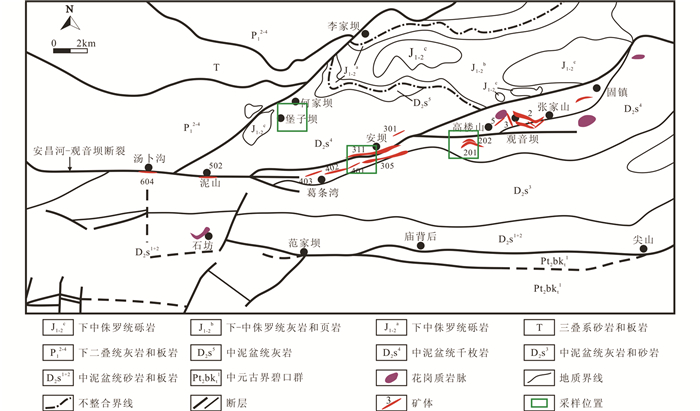
|
图 2 阳山金矿带矿床地质图(据赵成海, 2009; 李楠等, 2012修改) Fig. 2 Deposit geological map of the Yangshan gold belt (modified after Zhao, 2009; Li et al., 2012) |
矿床的赋矿围岩主要包括千枚岩、花岗质岩脉、大理岩化灰岩和变质石英砂岩,其中以千枚岩和花岗质岩脉为主。因受到构造作用的改造以及蚀变矿化热液的影响,矿石一般较为松散破碎。矿石矿物主要为黄铁矿、毒砂和辉锑矿,含有少量的自然金、银金矿、黄铜矿、闪锌矿和方铅矿等,脉石矿物主要为石英、方解石、白云石、长石和绢云母,可见少量的绿泥石、绿帘石、高岭石和叶腊石等。基于详细的野外露头、手标本以及显微镜观察,将阳山金矿带的成岩-成矿期次、阶段划分为成岩期和热液成矿期,其中热液成矿期又包括早阶段、主阶段和晚阶段,并识别出四个阶段的黄铁矿(成岩期和热液成矿期的三个阶段)、两个阶段的毒砂(主阶段和晚阶段)、一个阶段的辉锑矿(晚阶段)、少量的其他硫化物和硫盐矿物(李楠, 2013; Li et al., 2014)。
常见矿化样式为微细浸染状矿化,其次为脉状-细脉状矿化。微细浸染状矿化主要发育于千枚岩、花岗质岩脉、大理岩化灰岩和变质石英砂岩中(图 3a-c),可见于变质成岩期和成矿期的各阶段。矿化千枚岩和矿化花岗质岩脉普遍见于六个金矿床中;而矿化大理岩化灰岩主要见于观音坝矿床;矿化变质砂岩只见于少数矿点。脉状-细脉状矿化较为少见。少量的金赋存于成矿早阶段和主阶段的硫化物-石英脉中(图 3d)。成矿晚阶段的烟灰色石英±方解石脉中可见自然金和辉锑矿,脉宽2~50cm,主要见于千枚岩与花岗质岩脉接触带(图 3e)。在花岗质岩脉和少量的变质石英砂岩中可见宽2~5mm的辉锑矿-石英细脉。成矿晚阶段的石英±方解石脉一般为近NE向,切穿了更早形成的微细浸染状矿化和脉状矿化(图 3f)。成矿晚阶段石英脉中,黄铁矿为他形-自形晶体,粒度为0.005~0.05mm;毒砂为自形晶体,粒径为0.005~0.1mm;辉锑矿为他形晶体,充填在石英或方解石晶体的空隙中,包裹了更早形成的黄铁矿和毒砂(图 3g)。辉锑矿-石英±方解石脉中可见自然金(图 3h)。总体上,脉状金-锑矿化发育位置较浅,而微细浸染状金矿化发育位置较深。
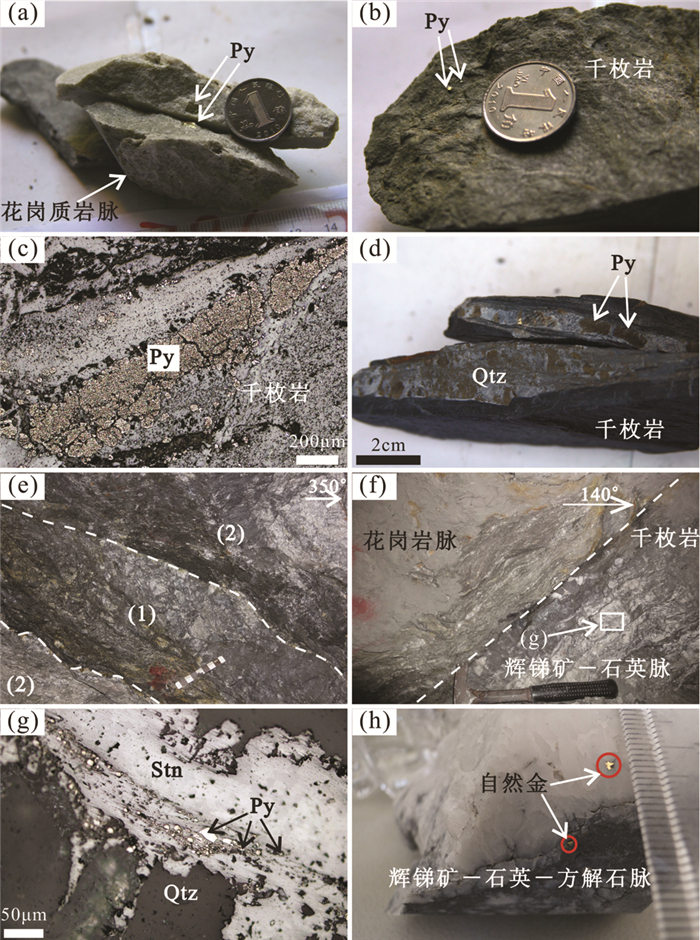
|
图 3 阳山金矿带矿化样式与矿石矿物特征 (a)花岗质岩脉中的微细浸染状黄铁矿;(b)千枚岩中的微细浸染状硫化物;(c)千枚岩中的层状半块状粗粒黄铁矿;(d)平行于千枚理的黄铁矿-石英脉;(e)破碎带中的辉锑矿-石英脉和石英角砾,(1)辉锑矿-石英脉和石英角砾,(2)千枚岩;(f)花岗岩脉与千枚岩的接触面,白色虚线左侧为花岗岩脉,右侧为千枚岩,两者都可见较多的黄铁矿和毒砂,接触面靠近千枚岩的一侧发育25cm宽的辉锑矿-石英脉,包裹了黄铁矿和毒砂;(g)辉锑矿-石英脉包裹了成矿主阶段的黄铁矿;(h)自然金-辉锑矿-石英-方解石脉. Py-黄铁矿;Qtz-石英;Stn-辉锑矿 Fig. 3 Mineralization styles and ore minerals of the Yangshan gold belt (a) disseminated pyrite in granitic dikes; (b) disseminated sulfides in phyllite; (c) semi-massive pyrite aggregate in phyllite; (d) pyrite-quartz vein parallel to the phyllitic foliation; (e) stibnite-quartz vein and quartz breccias in fracture zone; (f) the white dash line indicates the contact plane of granite and phyllite, and the left part is granite while the right part is phyllite, both of which are rich in pyrite and arsenopyrite. The 25-cm wide stibnite-quartz vein overprints the pyrite-arsenopyrite mineralization in phyllite; (g) pyrite-arsenopyrite-stibnite-quartz vein in phyllite that is adjacent to granite dike; (h) native gold-stibnite-quartz-calcite vein, with the red circle indicating native gold. Py-pyrite; Qtz-quartz; Stn-stibnite |
金矿带可识别出成矿前、成矿期和成矿后的石英脉。成矿前的石英脉一般呈白色或烟灰色,被矿化千枚理切穿,或者为顺千枚理的变质期石英脉,广泛分布于千枚岩中。成矿早阶段可见平行于千枚理的石英纤维,且与黄铁矿的显微破碎共生,显示出韧性-脆性的变形环境(李楠, 2013)。成矿早阶段和主阶段可见细粒黄铁矿-石英脉和黄铁矿-毒砂-石英脉,切穿了千枚理,脉中及边部见细粒黄铁矿及毒砂单矿物。与成矿早、主阶段的矿化石英脉相比,晚阶段的辉锑矿-石英±方解石脉发育更为普遍。辉锑矿为铅灰色或钢灰色,黑色条痕,不透明,强金属光泽,硬度低,解理面上横纹发育。辉锑矿多呈他形团块状,其次为针簇状或短针状,石英脉中可见针簇状辉锑矿的晶洞。石英为白色,自形,显微镜下可见生长环带。辉锑矿-石英±方解石脉多位于千枚岩破碎带或千枚岩与花岗质岩脉接触带,另有少量直接赋存于千枚岩、花岗质岩脉、千枚岩夹薄层大理岩化灰岩之中(图 4a、图 5a),局部可见少量明金。辉锑矿和石英样品的采样位置见图 2。
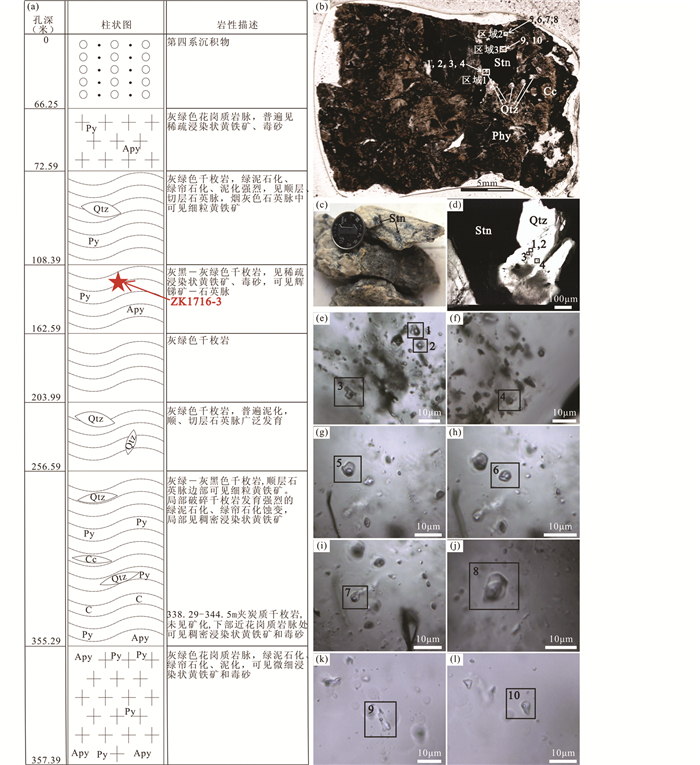
|
图 4 样品ZK1716-3中的流体包裹体组合岩相学照片 (a)钻孔柱状图及取样位置;(b)流体包裹体与辉锑矿和石英的位置关系;(c)手标本照片;(d-l)流体包裹体照片.Apy-毒砂;C-炭质千枚岩;Cc-方解石;Phy-千枚岩;Py-黄铁矿;Qtz-石英;Stn-辉锑矿;黑/白色框及数字-流体包裹体及编号 Fig. 4 Petrographic photos of fluid inclusion assemblages of the sample ZK1716-3 (a) drill hole columnar section and sampling location; (b) the locations of fluid inclusions and relationship with stibnite and quartz; (c) hand specimen; (d-l) photos of fluid inclusions. Apy-arsenopyrite; C-carbonaceous phyllite; Cc-calcite; Phy-phyllite; Py-pyrite; Qtz-quartz; Stn-stibnite; black/white boxes and numbers-fluid inclusions and their numbers |

|
图 5 样品SM2-2次生包裹体组合岩相学照片 (a)千枚岩中的辉锑矿-石英脉;(b)流体包裹体的位置;(c)被辉锑矿包裹的的石英颗粒;(d-f)流体包裹体照片. Phy-千枚岩;Qtz-石英;Stn-辉锑矿;黑色框及数字-待研究流体包裹体及编号 Fig. 5 Petrographic photos of secondary fluid inclusion assemblages of the sample SM2-2 (a) stibnite-quartz vein in phyllite; (b) location of fluid inclusions; (c) quartz grains surrounded by stibnite; (d-f) photos of fluid inclusions. Phy-phyllite; Qtz-quartz; Stn-stibnite; black/white boxes and numbers-studies fluid inclusions and their numbers |
在细致的岩相学工作基础上,挑选出被辉锑矿包裹的石英中的流体包裹体组合进行均一温度测定。流体包裹体显微测温在美国地质调查局丹佛中心流体包裹体实验室进行。实验仪器为英国Linkam公司生产的THMSG600显微冷热台,该系统还包括TMS92程序控制器和LNP2液氮冷却系统,使用软件为Linksys software version 2.23。该冷热台由SYN FLINC标样进行校正:在温度接近或者低于0℃时,冷热台的精确度为±0.1℃;温度为200~400℃时,精确度为±0.1℃。
全岩样品先用蒸馏水清洗,再粉碎,缩分,研磨至200目备用。将矿石样品逐级破碎,过筛后,在双目镜下挑选40~60目的辉锑矿和石英单矿物,使其纯度在99%以上,经玛瑙研钵研磨至200目。全岩样品、辉锑矿和石英稀土和微量元素测试在中国地质大学(北京)地质过程与矿产资源国家重点实验室完成,测试仪器为电感耦合等离子质谱仪(ICP-MS),分析误差优于10%,测试前的溶样和测试具体操作见张红雨等(2012)。稀土和微量元素数据分别经球粒陨石(Sun and McDonough, 1989; Thompson, 1982)标准化处理。
4 结果与分析 4.1 流体包裹体岩相学与显微测温结果成矿早、主阶段的石英脉通常较为细小,流体包裹体期次复杂,而且难以找到被黄铁矿或毒砂包裹的流体包裹体;而成矿晚阶段的辉锑矿-石英±方解石脉较为发育,且较易找到被辉锑矿包裹的石英(图 4b-d、图 5b, c)。进一步对该石英中的流体包裹体组合进行研究,可见原生包裹体类型主要为气液两相水溶液包裹体和含CO2的三相包裹体,次生包裹体类型为气液两相水溶液包裹体(图 5d-f)。原生含CO2的三相包裹体零散分布在辉锑矿包裹的石英中,椭圆形,大小为3~6μm,少数可达12μm,包裹体的充填度为45%~50%。原生气液两相包裹体呈不规则状、大小约6μm,包裹体的充填度为2%(图 4e-l、表 1)。
|
|
表 1 阳山金矿带成矿晚阶段流体包裹体组合及显微测温结果 Table 1 Late ore stage fluid inclusion assemblages and microthermometry data of the Yangshan gold belt |
样品ZK1716-3以及SM2-2中包裹体组合的显微测温结果如表 1所示。原生包裹体组合有两个:(1)ZK1716-3中的区域1,含CO2的三相包裹体充填度为45%~50%,均一温度为288.3℃(包裹体组合内单个包裹体均一温度变化范围为283.5~293.1℃);(2)ZK1716-3的区域2,含CO2三相包裹体充填度为10%~20%,均一温度为271.3℃。次生包裹体组合有两个:(1)样品ZK1716-3的区域3,为气液两相包裹体,充填度为0.1%~1%,未测到相变温度;(2)样品SM2-2的区域1,包裹体为气液两相包裹体,充填度为2%~10%,均一温度为136.8℃(包裹体组合内单个包裹体均一温度变化范围为109.7~172℃)。
流体包裹体组合显微测温学研究结果显示,阳山金矿带成矿晚阶段流体富含CO2,均一温度为271.3~288.3℃,具有较窄的变化范围(变化范围为17℃),其数据符合流体包裹体组合测温数据的有效性。此外,尽管石英被辉锑矿包裹住,但仍然受到了成矿后较低温度流体(均一温度约为136.8℃)的改造。
根据显微测温数据,计算出成矿晚阶段流体盐度平均为3.2% NaCleqv(变化范围为2.2%~4.8% NaCleqv),属于低盐度的成矿流体。
4.2 辉锑矿的稀土和微量元素特征阳山金矿带成矿晚阶段辉锑矿的稀土和微量元素含量见表 2,本研究所涉及的不同地质体的稀土和微量元素含量未列入表内。本次研究所收集的阳山金矿带千枚岩和花岗质岩脉的稀土和微量元素数据来自李楠(2013),毒砂的稀土元素数据来自栗海宇(2014)。
|
|
表 2 阳山金矿带石英和辉锑矿稀土元素及微量元素含量(×10-6) Table 2 Trace element composition on late-ore stage quartz and stibnite in the Yangshan gold belt (×10-6) |
辉锑矿稀土总量为13.82×10-6~36.05×10-6,轻稀土总量为12.68×10-6~33.45×10-6,重稀土总量为0.54×10-6~2.60×10-6,轻重稀土比值(LREE/HREE)为5.87~44.9,(La/Yb)N比值为38.2~922,且主要集中在117~353,反映出辉锑矿轻重稀土分馏程度较高,整体上具有轻稀土富集、重稀土亏损的“右倾式”稀土配分模式。辉锑矿可见中-弱的负Eu异常(δEu值为0.49~0.83)和强的负Ce异常(δCe值为0.07~0.19)。与辉锑矿相比,成矿主阶段的毒砂具有中-弱的负Eu异常(δEu值平均为0.62),Ce异常不明显(δCe值平均为0.92;图 6; 栗海宇, 2014)。除此之外,辉锑矿中Dy元素显示出明显的正异常(图 6、表 2)。在(La/Sm)N-(La/Yb)N-(La/Lu)N三角图解中,阳山金矿带的辉锑矿数据落于含金辉锑矿的范围(图 7)。
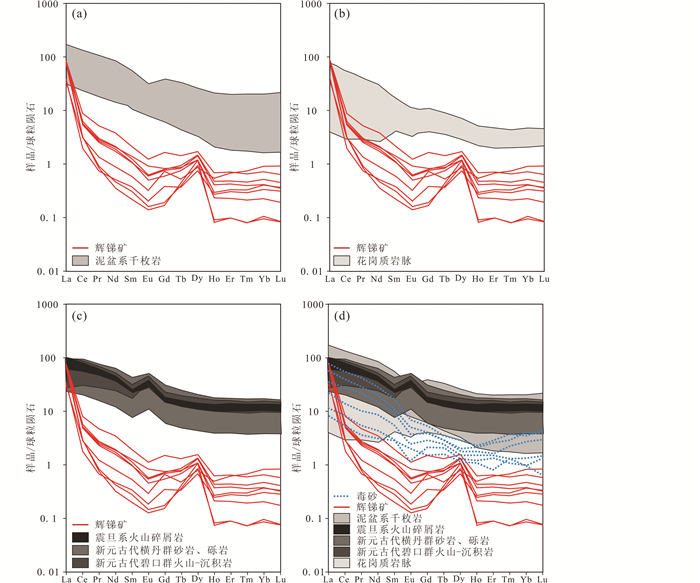
|
图 6 辉锑矿、毒砂及不同地质体球粒陨石标准化稀土配分曲线 Fig. 6 Chondrite-normalized REE patterns of stibnite, arsenopyrite and different geological bodies |

|
图 7 辉锑矿(La/Sm)N-(La/Yb)N-(La/Lu)N三角图解(贫金与含金辉锑矿的界线张国林, 1999) Fig. 7 The (La/Sm)N-(La/Yb)N-(La/Lu)N diagram of stibnite (the boundary line between gold-free and gold-rich after Zhang, 1999) |
由9件辉锑矿微量元素数据(图 8、表 2)可知,辉锑矿富含Ag(0.02×10-6~0.81×10-6)、Au(1.00×10-6~5.08×10-6)、As(197.1×10-6~604.0×10-6)、Cu(2.90×10-6~507.6×10-6)、Pb(0.03×10-6~133.0×10-6)、Se(0.92×10-6~6.01×10-6)等亲硫元素。此外,辉锑矿还富集Ba(111.7×10-6~334.6×10-6),Th(0.09×10-6~0.87×10-6)和La(9.66×10-6~24.14×10-6),亏损Nb、Ta、Sr和Ti元素。除了1个样品以外,8件辉锑矿微量元素特征值Hf/Sm < 1,所有的辉锑矿的Nb/La值和Th/La值均小于1。
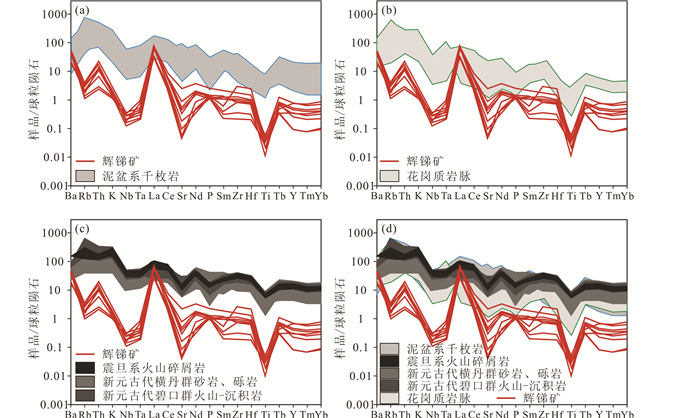
|
图 8 辉锑矿及不同地质体球粒陨石标准化微量元素蛛网图 Fig. 8 Chondrite-normalized spider diagrams of trace elements in stibnite and different geological bodies |
阳山金矿带成矿早、主和晚阶段的石英的稀土和微量元素含量见表 2。
成矿早、主和晚阶段的石英具有相似的稀土配分模式(图 9)。从早到晚,石英的稀土元素总量逐渐变大(平均值为1.98×10-6→2.74×10-6→3.28×10-6)。轻稀土总量为0.68×10-6~3.27×10-6,重稀土总量为0.26×10-6~1.92×10-6,轻重稀土比值(LREE/HREE)为1.44~3.32,(La/Yb)N比值为5.03~8.85,指示石英轻重稀土分馏程度较低,整体上呈轻稀土富集、重稀土亏损的“右倾式”稀土配分模式。三阶段石英具有不同程度的负Eu异常(δEu值为0.05~0.79),而Ce异常不明显。

|
图 9 不同成矿阶段石英的球粒陨石标准化稀土配分曲线和微量元素蛛网图 Fig. 9 Chondrite-normalized REE patterns and spider diagrams of trace elements in different stage quartz |
成矿早、主和晚阶段的石英具有相似的微量元素特征,石英富含Ag(0.02×10-6~0.18×10-6)、Au(0.01×10-6~0.54×10-6)、As(1.68×10-6~205.8×10-6)、Cu(1.01×10-6~14.88×10-6)、Pb(8.09×10-6~206.2×10-6)、Se(0.04×10-6~0.27×10-6)等亲硫元素。除此之外,阳山金矿带石英富集Rb(0.78×10-6~3.99×10-6)和K(249.8×10-6~994.0×10-6),亏损Nb、Sm和Ti元素。
5 讨论 5.1 微细浸染状金矿化与脉状金-锑矿化关系 5.1.1 空间和时间关系空间上,阳山金矿带金矿化主要呈微细浸染状分布于千枚岩和花岗质岩脉中,少量自然金分布于花岗质岩脉与千枚岩接触带的辉锑矿-石英±方解石脉中;锑矿化主要分布于花岗质岩脉与千枚岩接触带的石英±方解石脉中,少量锑分布于微细浸染状黄铁矿和毒砂中。总体上,脉状金-锑矿化发育位置较浅,微细浸染状金矿化发育位置较深。
时间上,变质成岩期黄铁矿中可见金的初步富集,成矿早到晚阶段都有金矿化,主阶段以黄铁矿和毒砂中的晶格金为主,晚阶段以自然金为主(Li et al., 2014);锑矿化主要以辉锑矿的形式赋存于成矿晚阶段石英±方解石脉中,且切穿了成矿主阶段的黄铁矿-毒砂矿化,少量锑矿化也见于成矿早、主阶段的硫化物中(李楠, 2013)。
5.1.2 成因关系成矿晚阶段脉状金-锑矿化流体富含CO2,均一温度为271.3~288.3℃,平均盐度为3.2% NaCleqv,与成矿主阶段微细浸染状金矿化流体特征(富CO2,均一温度为210~270℃,盐度 < 5% NaCleqv,李晶等, 2007;黄铁矿晶形反映成矿温度为200~300℃,李楠等, 2012)一致。毒砂和辉锑矿具有相似的Eu负异常,但辉锑矿具有更明显的Ce负异常,指示与主阶段相比,成矿晚阶段流体还原性略微降低(赵岩等, 2015)。辉锑矿富集轻稀土元素,且Hf/Sm、Nb/La和Th/La小于1,指示成矿流体为富Cl流体(Oreskes and Einaudi, 1990; 陈炳翰等, 2014),与主阶段流体富Cl特征一致(栗海宇, 2014)。各阶段石英具有相似的稀土配分模式和微量元素特征,也反映各阶段流体具有相似的性质。此外,成矿期不同阶段石英都具有均一且较重的δ18OV-SMOW值(变化范围为15.9‰~21.5‰; 李楠, 2013),与造山型金矿的δ18OV-SMOW值特征一致,反映出成矿流体来源为变质流体(Goldfarb et al., 1998; Groves et al., 1998)。
阳山金矿带辉锑矿呈轻稀土富集、重稀土亏损的“右倾式”稀土配分模式,并可见中-弱的Eu负异常和强的Ce负异常,与千枚岩和花岗质岩脉具有相似性,而与震旦系火山碎屑岩、新元古代碧口群和横丹群地层的Eu正异常和Ce正异常特征明显不同。辉锑矿富含Ag、Au、As等微量元素,符合低温含金辉锑矿的特征,这不仅归因于它们的亲硫特性,还与赋矿围岩(千枚岩和花岗质岩脉)中这些元素的高背景值有关(刘英俊和季峻峰, 1994; 李楠, 2013)。同时,硫化物硫同位素组成,也可提供成矿系统硫的来源、运移和沉淀机制等信息(Deng et al., 2017c; Yang et al., 2017b; 黄钰涵等, 2017)。阳山金矿带硫同位素研究显示,辉锑矿与毒砂、黄铁矿具有相同的硫源(李楠等, 2012)。
与成矿早、主阶段相比,成矿晚阶段的黄铁矿和毒砂具有更多的Sb和更少的As,且可见较多辉锑矿,指示该阶段流体富含Sb元素而较贫As元素(李楠, 2013; Li et al., 2014)。金与砷伴生进入黄铁矿和毒砂等硫化物的晶格已经得到了广泛认可(Reich et al., 2005; Deditius et al., 2014),而当成矿流体演化为相对富Sb、贫As、且温度压力相对较低的晚阶段(李楠, 2013),金、锑等成矿物质不会进入黄铁矿、毒砂晶格中,而是直接从成矿流体中沉淀下来,形成脉状矿化。成矿主阶段黄铁矿和毒砂的沉淀消耗了大量的S2-,晚阶段成矿流体进入较浅的张性空间,释放出H2S,成矿流体中S2-浓度显著降低,导致金硫络合物分解(Hayashi and Ohmoto, 1991),从而使自然金沉淀下来。同时,成矿温度和硫逸度的降低,也促使辉锑矿沉淀下来(Williams-Jones and Norman, 1997; Simon et al., 1999; Zhu et al., 2011)。
可见,脉状金-锑矿化与微细浸染状金矿化具有相似的成矿流体特征,不同于高温、高盐度特征的岩浆流体(陈衍景等, 2007),而与典型造山型金矿变质流体特征一致(Groves et al., 1998; Goldfarb et al., 2005)。二者成矿物质来源一致,可能为赋矿的千枚岩和花岗质岩脉:在区域构造抬升引发的退变质过程中,千枚岩和花岗质岩脉发生变质脱挥发分作用,释放出金、砷、锑等成矿物质。成矿物理化学条件(温度、压力、硫逸度等)的变化以及成矿流体成分(尤其是As、Sb含量)的演化,导致金矿化与锑矿化具有不同的产出样式。
5.2 矿床成因与找矿意义造山型金矿的地壳连续成矿模式指出,从次绿片岩相到麻粒岩相的不同层次地壳深度都有金矿产出,成矿温度范围为180~700℃,成矿压力在100~500MPa之间变化,构造样式从浅部的脆性构造变化为深部的韧性构造,矿化样式从浅部的角砾状、脉状矿化变化为深部的微细浸染状矿化,辉锑矿等矿物出现于低变质级别的浅成环境(Groves, 1993; Groves et al., 1998; Goldfarb et al., 2005)。同时,地壳连续成矿模式适用于准同期的造山型金成矿作用,即不同地壳深度的成矿事件是近同时形成的(Vielreicher et al., 2015)。一般认为,地壳连续成矿模式反映了区域范围内一系列金矿床的垂向分布特征(杨立强等, 2014)。在阳山金矿带,金矿化与锑矿化贯穿了整个成矿作用,随着成矿温度、压力的变化,以及成矿流体成分的演化,成矿早、主阶段以微细浸染状含金硫化物为主,发育位置较深,成矿晚阶段以脉状自然金-辉锑矿矿化为主,发育位置较浅(Deng et al., 2010, 2011)。尽管阳山金矿带微细浸染状金矿化与脉状金-锑矿化都具有造山型金矿浅成矿化特征,在矿带尺度上,仍符合地壳连续成矿模式的垂向分布规律。
对阳山金矿带钻探和坑探工程资料的统计表明,所有金矿体均受控于安昌河-观音坝断裂系统(含主干断裂和次级断裂),多数金矿体定位于断裂构造与千枚岩的复合部位,少数定位于花岗质岩脉及其接触带(郭俊华等, 2009)。而断裂构造与千枚岩的复合部位主要为微细浸染状金矿化,千枚岩与花岗质岩脉接触带多为脉状金-锑矿化。由于千枚岩与花岗质岩脉能干性存在显著差异,二者接触带成为成矿流体沉淀聚集和成矿物质沉淀的理想场所,除了较多的脉状自然金-辉锑矿矿化之外,也可见较多的被脉状矿化切穿的微细浸染状含金黄铁矿-毒砂矿化。结合造山型金矿连续成矿模式中矿化样式的垂直分布规律,建议找矿勘探工作应在较浅部千枚岩与花岗质岩脉接触带寻找脉状自然金-辉锑矿矿脉,而在深部构造有利部位重点探寻微细浸染状金矿化。
6 结论微细浸染状金矿化分布于千枚岩和花岗质岩脉中,锑矿化主要分布于花岗质岩脉与千枚岩接触带的石英±方解石脉中。金矿化与锑矿化贯穿了整个成矿作用,前者比后者发育位置更深。成矿晚阶段流体具有中低温、低盐度、富Cl和CO2、还原性、来源于变质流体的特征,与成矿主阶段的成矿流体特征一致。硫化物和石英的稀土微量元素特征以及硫同位素值,反映出阳山金矿带成矿物质来源可能为赋矿的千枚岩和花岗质岩脉,且成矿各阶段物质来源一致。
成矿物理化学条件的变化以及成矿流体成分的演化,导致金矿化与锑矿化具有不同的产出样式,但不属于叠加成矿作用。微细浸染状金矿化与脉状金-锑矿化都具有造山型金矿浅成矿化特征,在矿带尺度上,符合地壳连续成矿模式的垂向分布规律,并指出了潜在的找矿勘探方向。
致谢 野外工作得到了武警黄金部队第十二支队广大官兵的帮助和支持;流体包裹体岩相学和显微测温工作得到了中国地质大学(北京)Richard Goldfarb教授、美国地质调查局丹佛中心Erin Marsh和Paul Emsbo研究员的协助;辉锑矿和石英稀土和微量元素测试工作得到中国地质大学(北京)地质过程与矿产资源国家重点实验室苏犁老师和张红雨老师的大力支持和帮助;中国地质大学(北京)杨立强教授以及两位审稿人提出了宝贵的修改建议;在此一并表达最诚挚的感谢!
Bierlein FP, Arne DC, Foster DA and Reynolds P. 2001. A geochronological framework for orogenic gold mineralisation in central Victoria, Australia. Mineralium Deposita, 36(8): 741-767. DOI:10.1007/s001260100203 |
Bodnar RJ. 2003. Introduction to fluid inclusions. In: Samson I, Anderson A and Marshall D (eds. ). Fluid Inclusions: Analysis and Interpretation. Ottawa: Mineralogical Association of Canada, 1-8
|
Chen BH, Wang ZL, Li HL, Li JK, Li JL and Wang GQ. 2014. Evolution of ore fluid of the Taishang gold deposit, Jiaodong:Constraints on REE and trace element component of auriferous pyrite. Acta Petrologica Sinica, 30(9): 2518-2532. |
Chen YJ, Ni P, Fan HR, Pirajno F, Lai Y, Su WC and Zhang H. 2007. Diagnostic fluid inclusions of different types hydrothermal gold deposits. Acta Petrologica Sinica, 23(9): 2085-2108. |
Chen YJ and Santosh M. 2014. Triassic tectonics and mineral systems in the Qinling Orogen, central China. Geological Journal, 49(4-5): 338-358. DOI:10.1002/gj.v49.4-5 |
Chi GX and Lu HZ. 2008. Validation and representation of fluid inclusion microthermometric data using the fluid inclusion assemblage (FIA) concept. Acta Petrologica Sinica, 24(9): 1945-1953. |
Deditius AP, Reich M, Kesler SE, Utsunomiya S, Chryssoulis SL, Walshe J and Ewing RC. 2014. The coupled geochemistry of Au and As in pyrite from hydrothermal ore deposits. Geochimica et Cosmochimica Acta, 140: 644-670. DOI:10.1016/j.gca.2014.05.045 |
Deng J, Wang QF, Yang LQ, Wang YR, Gong QJ and Liu H. 2010. Delineation and explanation of geochemical anomalies using fractal models in the Heqing area, Yunnan Province, China. Journal of Geochemical Exploration, 105(3): 95-105. DOI:10.1016/j.gexplo.2010.04.005 |
Deng J, Hou ZQ, Mo XX, Yang LQ, Wang QF and Wang CM. 2010. Superimposed orogenesis and metallogenesis in Sanjiang Tethys. Mineral Deposits, 29(1): 37-42. |
Deng J, Wang QF, Wan L, Liu H, Yang LQ and Zhang J. 2011. A multifractal analysis of mineralization characteristics of the Dayingezhuang disseminated-veinlet gold deposit in the Jiaodong gold province of China. Ore Geology Reviews, 40(1): 54-64. DOI:10.1016/j.oregeorev.2011.05.001 |
Deng J, Ge LS and Yang LQ. 2013. Tectonic dynamic system and compound orogeny:Additionally discussing the temporal-spatial evolution of Sanjiang orogeny, Southwest China. Acta Petrologica Sinica, 29(4): 1099-1114. |
Deng J, Wang QF, Li GJ and Santosh M. 2014a. Cenozoic tectono-magmatic and metallogenic processes in the Sanjiang region, southwestern China. Earth-Science Reviews, 138: 268-299. DOI:10.1016/j.earscirev.2014.05.015 |
Deng J, Wang QF, Li GJ, Li CS and Wang CM. 2014b. Tethys tectonic evolution and its bearing on the distribution of important mineral deposits in the Sanjiang region, SW China. Gondwana Research, 26(2): 419-437. DOI:10.1016/j.gr.2013.08.002 |
Deng J, Wang QF, Li GJ and Zhao Y. 2015. Structural control and genesis of the Oligocene Zhenyuan orogenic gold deposit, SW China. Ore Geology Reviews, 65: 42-54. DOI:10.1016/j.oregeorev.2014.08.002 |
Deng J and Wang QF. 2016. Gold mineralization in China:Metallogenic provinces, deposit types and tectonic framework. Gondwana Research, 36: 219-274. DOI:10.1016/j.gr.2015.10.003 |
Deng J, Wang QF and Li GJ. 2016. Superimposed orogeny and composite metallogenic system:Case study from the Sanjiang Tethyan belt, SW China. Acta Petrologica Sinica, 32(8): 2225-2247. |
Deng J, Wang QF and Li GJ. 2017a. Tectonic evolution, superimposed orogeny, and composite metallogenic system in China. Gondwana Research, 50: 216-266. DOI:10.1016/j.gr.2017.02.005 |
Deng J, Liu XF, Wang QF, Dilek Y and Liang YY. 2017b. Isotopic characterization and petrogenetic modeling of Early Cretaceous mafic diking-lithospheric extension in the North China craton, eastern Asia. Geological Society of America Bulletin, 129(11-12): 1379-1407. DOI:10.1130/B31609.1 |
Deng J, Wang CM, Bagas L, Selvaraja V, Jeon H, Wu B and Yang LF. 2017c. Insights into ore genesis of the Jinding Zn-Pb deposit, Yunnan Province, China:Evidence from Zn and in-situ S isotopes. Ore Geology Reviews, 90: 943-957. DOI:10.1016/j.oregeorev.2016.10.036 |
Deng J, Wang CM, Bagas L, Santosh M and Yao EY. 2018. Crustal architecture and metallogenesis in the south-eastern North China Craton. Earth-Science Reviews, 182: 251-272. DOI:10.1016/j.earscirev.2018.05.001 |
Dong YP, Zhang GW, Neubauer F, Liu XM, Genser J and Hauzenberger C. 2011. Tectonic evolution of the Qinling orogen, China:Review and synthesis. Journal of Asian Earth Sciences, 41(3): 213-237. DOI:10.1016/j.jseaes.2011.03.002 |
Du ZT and Wu GG. 1998. Study on Tectonic Systems and Gold Metallogenic Tectono-Dynamics in the Region of West Qinling. Beijing: Geological Publishing House: 1-145.
|
Goldfarb RJ, Phillips GN and Nokleberg WJ. 1998. Tectonic setting of synorogenic gold deposits of the Pacific Rim. Ore Geology Reviews, 13(1-5): 185-218. DOI:10.1016/S0169-1368(97)00018-8 |
Goldfarb RJ, Baker T, Dube B, Groves DI, Hart CJR and Gosselin P. 2005. Distribution, character and genesis of gold deposits in metamorphic terranes. In: Hedenquist JW, Thompson JFH, Goldfarb RJ and Richards JP (eds. ). Economic Geology 100th Anniversary. Littleton: Society of Economic Geologists, 407-450
|
Goldstein RH and Reynolds TJ. 1994. Systematics of Fluid Inclusions in Diagenetic Minerals. Tulsa, Oklahoma: Society for Sedimentary Geology, 1-199 http://ci.nii.ac.jp/naid/10010291997
|
Groves DI. 1993. The crustal continuum model for Late-Archaean lode-gold deposits of the Yilgarn Block, Western Australia. Mineralium Deposita, 28(6): 366-374. DOI:10.1007/BF02431596 |
Groves DI, Goldfarb RJ, Gebre-Mariam M, Hagemann SG and Robert F. 1998. Orogenic gold deposits:A proposed classification in the context of their crustal distribution and relationship to other gold deposit types. Ore Geology Reviews, 13(1-5): 7-27. DOI:10.1016/S0169-1368(97)00012-7 |
Guo JH, Mao SD, Chen YJ, Qin Y, Yang FL, Li JZ and Nan ZL. 2009. Geological features and ore-controlling factors of the Yangshan gold field in Wen County, Gansu Province. Geotectonica et Metallogenia, 33(2): 243-252. |
Guo YY. 2016. Indosinian orogenic gold metallogenic deposits in the southern belt of the West Qinling, central China. Ph. D. Dissertation. Beijing: China University of Geosciences, 1-180 (in Chinese with English summary)
|
Hayashi KI and Ohmoto H. 1991. Solubility of gold in NaCl-and H2S-bearing aqueous solutions at 250~350℃. Geochimica et Cosmochimica Acta, 55(8): 2111-2126. DOI:10.1016/0016-7037(91)90091-I |
Huang YH, Deng J, Li GJ, Meng FQ, Mao FX and Zhang PF. 2017. Metallization process and metallogenic sources of concealed porphyry-skarn Mo deposit, Laochang, western Yunnan. Acta Petrologica Sinica, 33(7): 2099-2114. |
Ji XZ, Li N, Zhang C, Qiu KF, Hua B, Yu JY, Wu CJ and Han R. 2014. Elemental geochemistry characteristics and forming environment of cherts in the Mianlue tectonic zone. Acta Petrologica Sinica, 30(9): 2619-2630. |
Ji XZ. 2016. Regional metallogenic system in the Bikou terrane. Ph. D. Dissertation. Beijing: China University of Geosciences, 1-196 (in Chinese with English summary)
|
Ji XZ, Yang LQ, Santosh M, Li N, Zhang C, Zhang ZC, Han R, Li ZC and Wu CJ. 2016. Detrital zircon geochronology of Devonian quartzite from tectonic mélange in the Mianlue Suture Zone, Central China:Provenance and tectonic implications. International Geology Review, 58(12): 1510-1527. |
Jin XY, Li JW and Hofstra A. 2017. Possible two contrasting mineralization events of the Yata gold deposit in the Golden Triangle, SW China: New constraints from geochemistry, isotopes, and geochronology. In: SEG 2017 Conference Proceedings. Littleton: The Society of Economic Geologists, 184
|
Kalinin YA, Naumov EA, Borisenko AS, Kovalev KR and Antropova AI. 2015. Spatial-temporal and genetic relationships between gold and antimony mineralization at gold-sulfide deposits of the Ob-Zaisan folded zone. Geology of Ore Deposits, 57(3): 157-171. DOI:10.1134/S1075701515030022 |
Kovalev KR, Kalinin YA, Naumov EA and Myagkaya MK. 2014. Relationship of antimony with gold mineralization in the ore districts of Eastern Kazakhstan. Russian Geology and Geophysics, 55(10): 1170-1182. DOI:10.1016/j.rgg.2014.09.003 |
Li HY. 2014. Characteristics and significance of gold-bearing minerals from Anba gold deposit, in Wenxian, West Qinling. Master Degree Thesis. Beijing: China University of Geosciences, 1-65 (in Chinese with English summary)
|
Li J, Chen YJ, Li QZ, Lai Y, Yang RS and Mao SD. 2007. Fluid inclusion geochemistry and genetic type of the Yangshan gold deposit, Gansu, China. Acta Petrologica Sinica, 23(9): 2144-2154. |
Li JY, Wang ZQ and Zhao M. 1999. 40Ar-39Ar geochronology evidence for Mianlue collision zone in South Qinling mountain chain. Acta Geologica Sinica, 73(2): 189-190. |
Li N, Yang LQ, Zhang C, Zhang J, Lei SB, Wang HT, Wang HW and Gao X. 2012. Sulfur isotope characteristics of the Yangshan gold belt, West Qinling:Constraints on ore-forming environment and material source. Acta Petrologica Sinica, 28(5): 1577-1587. |
Li N. 2013. Geochemistry of ore-forming processes in the Yangshan gold belt, West Qinling, central China. Ph. D. Dissertation. Beijing: China University of Geosciences, 1-147 (in Chinese with English summary)
|
Li N, Deng J, Yang LQ, Goldfarb RJ, Zhang C, Marsh E, Lei SB, Koenig A and Lowers H. 2014. Paragenesis and geochemistry of ore minerals in the epizonal gold deposits of the Yangshan gold belt, West Qinling, China. Mineralium Deposita, 49(4): 427-449. DOI:10.1007/s00126-013-0498-8 |
Li N, Chen YJ, Santosh M and Pirajno F. 2015. Compositional polarity of Triassic granitoids in the Qinling Orogen, China:Implication for termination of the northernmost paleo-Tethys. Gondwana Research, 27(1): 244-257. DOI:10.1016/j.gr.2013.09.017 |
Li SG, Sun WD, Zhang GW, Chen JY and Yang YC. 1996. Chronology and geochemistry of metavolcanic rocks from Heigouxia Valley in the Mian-Lue tectonic zone, South Qinling:Evidence for a Paleozoic oceanic basin and its close time. Science in China (Series D), 39(3): 300-310. |
Liu JJ, Liu GZ, Liao YF, Zheng WJ, Yue LX, Hua SG, Mao GJ and Wu SH. 2008. Discovery and significance of scheelite orebodies in the Zhaishang gold deposit, southern Gansu. Geology in China, 35(6): 1113-1120. |
Liu YJ and Ji JF. 1994. Some characteristics of epithermal auriferous stibnite. Acta Mineralogica Sinica, 14(1): 68-73. |
Mo RW, Sun XM, Zhai W, Zhou F and Liang YH. 2013. Ore-forming fluid geochemistry and metallogenic mechanism from Mazhala gold-antimony deposit in southern Tibet, China. Acta Petrologica Sinica, 29(4): 1427-1438. |
Oreskes N and Einaudi MT. 1990. Origin of rare earth element-enriched hematite breccias at the Olympic Dam Cu-U-Au-Ag deposit, Roxby Downs, South Australia. Economic Geology, 85(1): 1-28. DOI:10.2113/gsecongeo.85.1.1 |
Peters SG, Huang JZ, Li ZP and Jing CG. 2007. Sedimentary rock-hosted Au deposits of the Dian-Qian-Gui area, Guizhou and Yunnan provinces, and Guangxi district, China. Ore Geology Reviews, 31(1-4): 170-204. DOI:10.1016/j.oregeorev.2005.03.014 |
Qiu KF, Taylor RD, Song YH, Yu HC, Song KR and Li N. 2016. Geologic and geochemical insights into the formation of the Taiyangshan porphyry copper-molybdenum deposit, Western Qinling Orogenic Belt, China. Gondwana Research, 35: 40-58. DOI:10.1016/j.gr.2016.03.014 |
Reich M, Kesler SE, Utsunomiya S, Palenik CS, Chryssoulis SL and Ewing RC. 2005. Solubility of gold in arsenian pyrite. Geochimica et Cosmochimica Acta, 69(11): 2781-2796. DOI:10.1016/j.gca.2005.01.011 |
Simon G, Kesler SE and Chryssoulis S. 1999. Geochemistry and textures of gold-bearing arsenian pyrite, Twin Creeks, Nevada:Implications for deposition of gold in carlin-type deposits. Economic Geology, 94(3): 405-421. DOI:10.2113/gsecongeo.94.3.405 |
Sun SS and Mcdonough WF. 1989. Chemical and isotopic systematics of oceanic basalts: Implications for mantle composition and processes. In: Sanders AD and Norry MJ (eds. ). Magmatism in Ocean Basins. Geological Society, London, Special Publication, 42(1): 313-345
|
Thompson RN. 1982. Magmatism of the British Tertiary Volcanic Province. Scottish Journal of Geology, 18(1): 49-107. DOI:10.1144/sjg18010049 |
Vielreicher N, Groves D, McNaughton N and Fletcher I. 2015. The timing of gold mineralization across the eastern Yilgarn craton using U-Pb geochronology of hydrothermal phosphate minerals. Mineralium Deposita, 50(4): 391-428. DOI:10.1007/s00126-015-0589-9 |
Wang XX, Wang T and Zhang CL. 2013. Neoproterozoic, Paleozoic, and Mesozoic granitoid magmatism in the Qinling Orogen, China:Constraints on orogenic process. Journal of Asian Earth Sciences, 72: 129-151. DOI:10.1016/j.jseaes.2012.11.037 |
Williams-Jones AE and Norman C. 1997. Controls of mineral parageneses in the system Fe-Sb-S-O. Economic Geology, 92(3): 308-324. DOI:10.2113/gsecongeo.92.3.308 |
Xia Y, Xie ZJ, Cline J and Yan BW. 2017. Miaolong sediment-hosted antimony-gold deposit, Sandu-Danzhai metallogenic belt, Guizhou Province, China: A product of antimony mineralization superimposed by late gold mineralization. In: SEG 2017 Conference Proceedings. SEG 2017: Ore Deposits of Asia: China and Beyond, Beijing, 2017. Littleton: The Society of Economic Geologists
|
Xiao CH, Li GJ, Liu H and Liang K. 2016. Characteristics of rare earth and trace elements of stibnite from the Bijiashan antimony deposit, Southwest Yunnan:Implications for ore genesis. Journal of Geomechanics, 22(2): 310-324. |
Xiao L, Zhao YS, Pan AJ, Han XJ, Cui L and Zou YL. 2008. An analysis of gold ore-controlling regularity and resource potential of western Qinling region. Mineral Deposits, 27(Suppl.1): 46-54. |
Yan FZ, Qi JZ and Guo JH. 2010. Geology and Exploration of Yangshan Gold Deposit in Gansu Province. Beijing: Geological Publishing House: 1-236.
|
Yang LQ, Liu JT, Zhang C, Wang QF, Ge LS, Wang ZL, Zhang J and Gong QJ. 2010. Superimposed orogenesis and metallogenesis:An example from the orogenic gold deposits in Ailaoshan gold belt, Southwest China. Acta Petrologica Sinica, 26(6): 1723-1739. |
Yang LQ, Deng J, Goldfarb RJ, Zhang J, Gao BF and Wang ZL. 2014. 40Ar/39Ar geochronological constraints on the formation of the Dayingezhuang gold deposit:New implications for timing and duration of hydrothermal activity in the Jiaodong gold province, China. Gondwana Research, 25(4): 1469-1483. DOI:10.1016/j.gr.2013.07.001 |
Yang LQ, Deng J, Wang ZL, Zhang L, Guo LN, Song MC and Zheng XL. 2014. Mesozoic gold metallogenic system of the Jiaodong gold province, eastern China. Acta Petrologica Sinica, 30(9): 2447-2467. |
Yang LQ, Deng J, Qiu KF, Ji XZ, Santosh M, Song KR, Song YH, Geng JZ, Zhang C and Hua B. 2015a. Magma mixing and crust-mantle interaction in the Triassic monzogranites of Bikou Terrane, central China:Constraints from petrology, geochemistry, and zircon U-Pb-Hf isotopic systematics. Journal of Asian Earth Sciences, 98: 320-341. DOI:10.1016/j.jseaes.2014.11.023 |
Yang LQ, Deng J, Dilek Y, Qiu KF, Ji XZ, Li N, Taylor RD and Yu JY. 2015b. Structure, geochronology, and petrogenesis of the Late Triassic Puziba granitoid dikes in the Mianlue suture zone, Qinling orogen, China. Geological Society of America Bulletin, 127(11-12): 1831-1854. DOI:10.1130/B31249.1 |
Yang LQ, Ji XZ, Santosh M, Li N, Zhang ZC and Yu JY. 2015c. Detrital zircon U-Pb ages, Hf isotope, and geochemistry of Devonian chert from the Mianlue suture:Implications for tectonic evolution of the Qinling orogen. Journal of Asian Earth Sciences, 113(Part 2): 589-609. |
Yang LQ, Gao X and He WY. 2015. Late Cretaceous porphyry metallogenic system of the Yidun arc, SW China. Acta Petrologica Sinica, 31(11): 3155-3170. |
Yang LQ, Deng J, Li N, Zhang C, Ji XZ and Yu JY. 2016a. Isotopic characteristics of gold deposits in the Yangshan gold belt, West Qinling, central China:Implications for fluid and metal sources and ore genesis. Journal of Geochemical Exploration, 168: 103-118. DOI:10.1016/j.gexplo.2016.06.006 |
Yang LQ, Deng J, Guo LN, Wang ZL, Li XZ and Li JL. 2016b. Origin and evolution of ore fluid, and gold-deposition processes at the giant Taishang gold deposit, Jiaodong Peninsula, eastern China. Ore Geology Reviews, 72(Part 1): 585-602. |
Yang LQ, Deng J, Wang ZL, Guo LN, Li RH, Groves DI, Danyushevsky LV, Zhang C, Zheng XL and Zhao H. 2016c. Relationships between gold and pyrite at the Xincheng gold deposit, Jiaodong Peninsula, China:Implications for gold source and deposition in a brittle epizonal environment. Economic Geology, 111(1): 105-126. DOI:10.2113/econgeo.111.1.105 |
Yang LQ, Deng J, Gao X, He WY, Meng JY, Santosh M, Yu HJ, Yang Z and Wang D. 2017a. Timing of formation and origin of the Tongchanggou porphyry-skarn deposit:Implications for Late Cretaceous Mo-Cu metallogenesis in the southern Yidun Terrane, SE Tibetan Plateau. Ore Geology Reviews, 81: 1015-1032. DOI:10.1016/j.oregeorev.2016.03.015 |
Yang LQ, Guo LN, Wang ZL, Zhao RX, Song MC and Zheng XL. 2017b. Timing and mechanism of gold mineralization at the Wang'ershan gold deposit, Jiaodong Peninsula, eastern China. Ore Geology Reviews, 88: 491-510. DOI:10.1016/j.oregeorev.2016.06.027 |
Yuan SS. 2015. Superimposed metallogenic model of the Yangshan gold belt, Western Qinling orogen, Gansu Province. Ph. D. Dissertation. Beijing: China University of Geosciences, 1-162 (in Chinese with English summary)
|
Zhai W, Sun XM, Yi JZ, Zhang XG, Mo RW, Zhou F, Wei HX and Zeng QG. 2014. Geology, geochemistry, and genesis of orogenic gold-antimony mineralization in the Himalayan Orogen, South Tibet, China. Ore Geology Reviews, 58: 68-90. DOI:10.1016/j.oregeorev.2013.11.001 |
Zhang GL. 1999. Geochemistry of rare earth elements and more elements of antimonite. Mineral Resources and Geology, 13(1): 13-19. |
Zhang GW, Guo AL and Yao AP. 2004. Western Qinling-Songpan continental tectonic node in China's continental tectonics. Earth Science Frontiers, 11(3): 23-32. |
Zhang HY, Su L, Qin H, Li J, Li YG and Li X. 2012. Study of ICP-MS detection about trace elements and noble metal elements in sulfides. Journal of Chemical Engineering and Technology, 2(3): 67-72. |
Zhang J, Li L, Gilbert S, Liu JJ and Shi WS. 2014. LA-ICP-MS and EPMA studies on the Fe-S-As minerals from the Jinlongshan gold deposit, Qinling Orogen, China:Implications for ore-forming processes. Geological Journal, 49(4-5): 482-500. DOI:10.1002/gj.v49.4-5 |
Zhang ZC, Li N, Ji XZ, Han Z, Guo YY and Li ZC. 2015. Hydrothermal alteration of the Anba deposit, Yangshan gold belt, western Qinling. Acta Petrologica Sinica, 31(11): 3405-3419. |
Zhang ZQ, Zhang GW, Tang SH, Xu JF, Yang YC and Wang JH. 2002. Age of Anzishan granulites in the Mianxian-Lueyang suture zone of Qingling orogen:With a discussion of the timing of final assembly of Yangtze and North China Craton blocks. Chinese Science Bulletin, 47(22): 1925-1930. DOI:10.1360/02tb9420 |
Zhao CH. 2009. Discussion of the genesis of super-large gold deposit in Yangshan, Gansu. Bulletin of Mineralogy, Petrology and Geochemistry, 28(3): 286-293. |
Zhao Y, Huang YH, Liang K and Zhang QN. 2015. Rare earth element and trace element features of auriferous pyrite in the Zhenyuan gold deposit, Sanjiang region, Yunnan Province, China. Acta Petrologica Sinica, 31(11): 3297-3308. |
Zhu YF, An F and Tan JJ. 2011. Geochemistry of hydrothermal gold deposits:A review. Geoscience Frontiers, 2(3): 367-374. DOI:10.1016/j.gsf.2011.05.006 |
陈炳翰, 王中亮, 李海林, 李金奎, 李京濂, 王国强. 2014. 胶东台上金矿床成矿流体演化:载金黄铁矿稀土元素和微量元素组成约束. 岩石学报, 30(9): 2518-2532. |
陈衍景, 倪培, 范宏瑞, Pirajno F, 赖勇, 苏文超, 张辉. 2007. 不同类型热液金矿系统的流体包裹体特征. 岩石学报, 23(9): 2085-2108. |
池国祥, 卢焕章. 2008. 流体包裹体组合对测温数据有效性的制约及数据表达方法. 岩石学报, 24(9): 1945-1953. |
邓军, 侯增谦, 莫宣学, 杨立强, 王庆飞, 王长明. 2010. 三江特提斯复合造山与成矿作用. 矿床地质, 29(1): 37-42. |
邓军, 葛良胜, 杨立强. 2013. 构造动力体制与复合造山作用——兼论三江复合造山带时空演化. 岩石学报, 29(4): 1099-1114. |
邓军, 王庆飞, 李龚健. 2016. 复合造山和复合成矿系统:三江特提斯例析. 岩石学报, 32(8): 2225-2247. |
杜子图, 吴淦国. 1998. 西秦岭地区构造体系及金成矿构造动力学. 北京: 地质出版社: 1-145.
|
郭俊华, 毛世东, 陈衍景, 秦艳, 杨福立, 李建忠, 南争路. 2009. 甘肃文县阳山金矿田地质特征及控矿地质因素分析. 大地构造与成矿学, 33(2): 243-252. |
郭耀宇. 2016. 西秦岭金矿带南亚带印支期造山型金成矿系统. 博士学位论文. 北京: 中国地质大学, 1-180 http://cdmd.cnki.com.cn/Article/CDMD-11415-1016067636.htm
|
黄钰涵, 邓军, 李龚健, 蒙福清, 毛富祥, 张鹏飞. 2017. 滇西老厂隐伏斑岩-矽卡岩型钼矿床成矿过程与物质来源. 岩石学报, 33(7): 2099-2114. |
戢兴忠, 李楠, 张闯, 邱昆峰, 华北, 余金元, 吴春俊, 韩日. 2014. 勉略构造带硅质岩元素地球化学特征及其形成环境. 岩石学报, 30(9): 2619-2630. |
戢兴忠. 2016. 碧口地体区域成矿系统. 博士学位论文. 北京: 中国地质大学, 1-196 http://cdmd.cnki.com.cn/Article/CDMD-11415-1016067643.htm
|
栗海宇. 2014. 西秦岭文县安坝金矿床载金矿物特征及其意义. 硕士学位论文. 北京: 中国地质大学, 1-65 http://cdmd.cnki.com.cn/Article/CDMD-11415-1014239463.htm
|
李晶, 陈衍景, 李强之, 赖勇, 杨荣生, 毛世东. 2007. 甘肃阳山金矿流体包裹体地球化学和矿床成因类型. 岩石学报, 23(9): 2144-2154. |
李锦轶, 王宗起, 赵民. 1999. 秦岭山脉南部勉略碰撞带造山作用时代的40Ar/39Ar年代学证据. 地质学报, 73(2): 189-190. |
李楠, 杨立强, 张闯, 张静, 雷时斌, 王恒涛, 王宏伟, 高雪. 2012. 西秦岭阳山金矿带硫同位素特征:成矿环境与物质来源约束. 岩石学报, 28(5): 1577-1587. |
李楠. 2013. 阳山金矿带成矿作用地球化学. 博士学位论文. 北京: 中国地质大学, 1-147 http://cdmd.cnki.com.cn/Article/CDMD-11415-1013267271.htm
|
刘家军, 刘光智, 廖延福, 郑卫军, 岳连雄, 华曙光, 毛光剑, 吴胜华. 2008. 甘肃寨上金矿床中白钨矿矿体的发现及其特征. 中国地质, 35(6): 1113-1120. |
刘英俊, 季峻峰. 1994. 低温含金辉锑矿的某些特征. 矿物学报, 14(1): 68-73. |
莫儒伟, 孙晓明, 翟伟, 周峰, 梁业恒. 2013. 藏南马扎拉金锑矿床成矿流体地球化学和成矿机制. 岩石学报, 29(4): 1427-1438. |
肖昌浩, 李龚健, 刘欢, 梁坤. 2016. 云南巍山笔架山锑矿床辉锑矿稀土微量元素特征及其矿床成因意义. 地质力学学报, 22(2): 310-324. |
肖力, 赵玉锁, 潘爱军, 韩先菊, 崔龙, 邹依林. 2008. 西秦岭金矿控矿规律和资源潜力分析. 矿床地质, 27(增1): 46-54. |
阎凤增, 齐金忠, 郭俊华. 2010. 甘肃省阳山金矿地质与勘查. 北京: 地质出版社.
|
杨立强, 刘江涛, 张闯, 王庆飞, 葛良胜, 王中亮, 张静, 龚庆杰. 2010. 哀牢山造山型金成矿系统:复合造山构造演化与成矿作用初探. 岩石学报, 26(6): 1723-1739. |
杨立强, 邓军, 王中亮, 张良, 郭林楠, 宋明春, 郑小礼. 2014. 胶东中生代金成矿系统. 岩石学报, 30(9): 2447-2467. |
杨立强, 高雪, 和文言. 2015. 义敦岛弧晚白垩世斑岩成矿系统. 岩石学报, 31(11): 3155-3170. |
袁士松. 2015. 西秦岭阳山金矿带叠加成矿模式. 博士学位论文. 北京: 中国地质大学, 1-162 http://cdmd.cnki.com.cn/Article/CDMD-11415-1015391706.htm
|
张国林. 1999. 辉锑矿中稀土及多元素地球化学特征. 矿产与地质, 13(1): 13-19. |
张国伟, 郭安林, 姚安平. 2004. 中国大陆构造中的西秦岭-松潘大陆构造结. 地学前缘, 11(3): 23-32. |
张红雨, 苏犁, 秦红, 李娇, 李艳广, 李玄. 2012. 硫化物矿物中多组分元素ICP-MS测定方法研究. 化学工程与技术, 2(3): 67-72. |
张志超, 李楠, 戢兴忠, 韩忠, 郭耀宇, 李在春. 2015. 西秦岭阳山金矿带安坝矿床热液蚀变作用. 岩石学报, 31(11): 3405-3419. |
赵成海. 2009. 甘肃阳山超大型金矿成因研究评述. 矿物岩石地球化学通报, 28(3): 286-293. |
赵岩, 黄钰涵, 梁坤, 张岐能. 2015. 西南三江地区镇沅金矿载金黄铁矿稀土与微量元素特征. 岩石学报, 31(11): 3297-3308. |
 2018, Vol. 34
2018, Vol. 34

